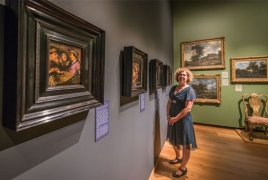Rembrandt's four earliest paintings reunited at the Ashmolean September 20, 2016 - 16:45 AMT PanARMENIAN.Net - The Ashmolean has opened a historic display of Rembrandt’s four earliest paintings, reuniting them for the first time in public, Art Daily said. Hearing, Touch, Smell and Sight are the four surviving panels from Rembrandt’s Five Senses series, created around 1624−5 when the artist was still a teenager. The display of the four paintings has been made possible through the generosity of the Leiden Collection, New York, a private collection assembled by Thomas S. Kaplan and Daphne Recanati Kaplan which has lent Hearing, Touch and Smell; and Museum de Lakenhal, Leiden which has lent Sight . The whereabouts of the fifth panel, which would depict Taste , is currently unknown and an empty frame in the exhibition space invites visitors to imagine how the missing painting might have looked. A year ago only three of the four panels were known and the Ashmolean’s display follows the ‘sensational’ rediscovery of the Unconscious Patient (Allegory of Smell) in 2015. The latter was found in the basement of a house in New Jersey, USA, and was offered at auction as a minor 19th-century painting at an estimate of $500–$800. Two eagle-eyed experts in European auction houses suspected that the picture was an early Rembrandt and the bidding war resulted in a hammer price of $870,000. The painting was subsequently purchased by the Leiden Collection, New York, and the attribution to Rembrandt was immediately confirmed by the presence of the artist’s monogram – ‘RHF’ – standing for ‘Rembrandt Harmenszoon Fecit’ (‘Rembrandt, son of Harmen, made this’). This newly discovered panel – with the artist’s earliest known signature - was unveiled to the public and worldwide press at the TEFAF art fair in Maastricht earlier this year. The Ashmolean’s display reunites this new discovery with Sight, Hearing and Touch for the first time. ‘We are truly thrilled and most proud that the first museum to exhibit Rembrandt’s four earliest paintings together, including his first known signed work, is the Ashmolean,’ says Dr. Thomas Kaplan, alumnus of the University of Oxford and long-term supporter of the Ashmolean Museum. ’Itself an incubator of a multitude of talents that have changed the world in so many ways, there are few more appropriate venues than Oxford in which to behold the first blush of genius that changed the arc of art history.’ The Senses panels precede Rembrandt’s better-known paintings and are clearly the work of a young artist who is still developing his own style. Despite the artist’s youth, these works show great promise and glimpses of the celebrated painter that Rembrandt would become in his bold use of bright colours and broad brushwork; an ability to capture human expression; and an experimental treatment of light. ‘The Five Senses’ were popular allegorical themes in the art of the Low Countries. Early treatments of the subjects often represented one of the senses with a female figure – an elegant woman holding a flower would symbolize ‘Smell’ for instance. Gradually the senses were interpreted in a more moralising fashion and from the 17th century onwards the subject was shown in genre scenes of debauched peasants: amorous couples embracing might represent ‘Touch’ or a scene of drunkenness would show ‘Taste’. Rembrandt’s series clearly belongs to this later type, each painting featuring three half-length figures in a constricted space engaged in an activity representing the sense. He also conveys a subtle undertone of satire in each of the scenes. In A Pedlar selling Spectacles (Allegory of Sight) a squinting woman tries on a pair of glasses while an old man gestures to his large nose as he is handed a pince-nez by the clearly untrustworthy street vendor. Rembrandt plays on the double meaning of the Dutch expression ‘to sell someone glasses’ – a metaphor for deceiving people. This panel also demonstrates Rembrandt’s talent for depicting surface and texture. In the subtlest of accents he conveys the shiny frames of the pince-nez and the glistening clasp of the pedlar’s money pouch. The young Rembrandt’s talents are particularly present in the newly discovered Allegory of Smell in which the textures of the oriental costumes, fur and jewelry almost appear tangible. The cloth which the woman is holding underneath the young man’s nose is a virtuoso handling of the paint, rendered in only a few brush strokes. An Van Camp, Curator of Northern European Art, Ashmolean Museum, says: ‘These earliest of paintings by Rembrandt are fascinating in what they tell us of the young artist’s abilities and his precociousness. The paintings show that at the age of just eighteen, Rembrandt already has a genius for representing human character and emotion, and for packing in amazing amounts of detail into the briefest of brushstrokes – skills that would see him become one of the most celebrated artists of all time.’ The fifth painting, Taste, remains lost and has possibly been destroyed in the nearly 400 years since it was painted. Equally, it may be languishing in someone’s attic. Bringing together the four other works in the Senses series offers an unprecedented opportunity for people to imagine what the missing picture might look like. The creative crew of the Public TV had chosen 13-year-old Malena as a participant of this year's contest. She called on others to also suspend their accounts over the companies’ failure to tackle hate speech. Penderecki was known for his film scores, including for William Friedkin’s “The Exorcist”, Stanley Kubrick’s “The Shining”. The festival made the news public on March 19, saying that “several options are considered in order to preserve its running” Partner news |